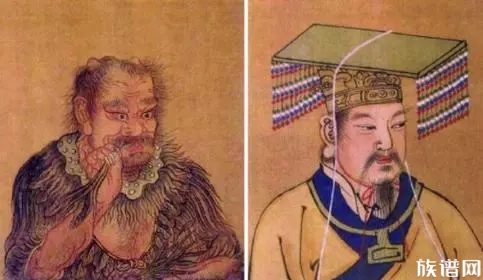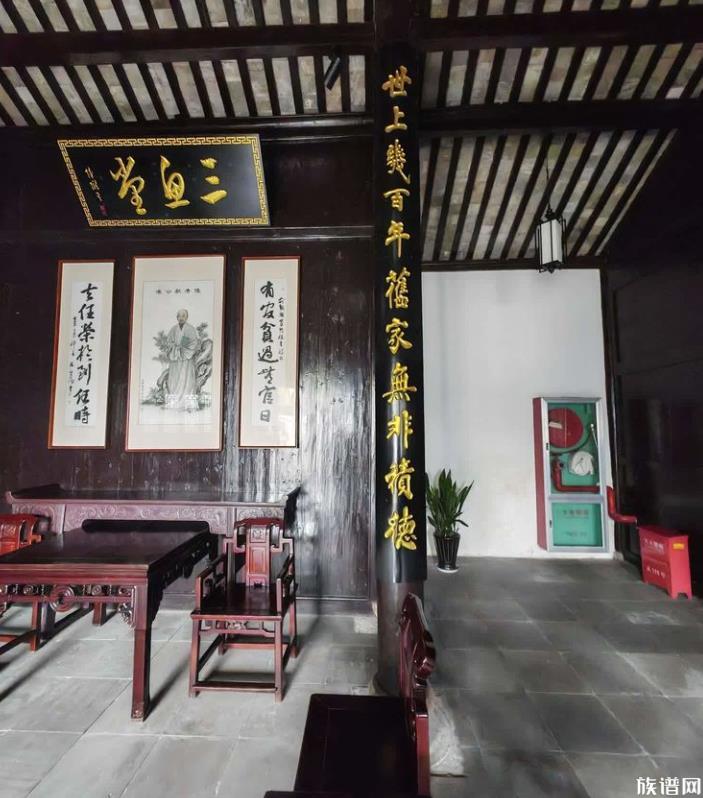



沙克达教
概述
性力派崇拜女神,认为性是宇宙间的根本动力,是智慧和力量的集中表现,男女交合、双抱双修才能获得精神解脱和无上福乐。这种修炼不同于尘世的淫乐,主张追求更高超的目标,他们边交媾,边口念箴言,使男女两性达到完美的结合,这就是修行者以性乐而达到悟道的目的。
沙克提和湿婆
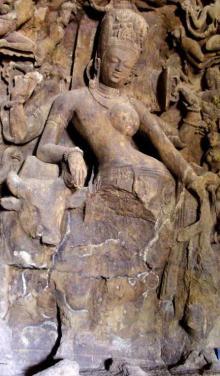
湿婆和沙克提的半男半女形式Ardhanari。(象岛石窟,公元5世纪。印度孟买。)
性力派信徒视女神为至高、终极的神格。她被认为是万物的起源,同时也是起源的化身和支配控制它的能量。有观察认为,“全世界信仰的历史上,没有其他任何地方经历过如我们这样如此完备的面向女性的系统。”
性力派对女神的专注并不意味着其对男性或中性神明的拒绝。然而在沙克提存在中,两者被认为是不活跃的。如Adi Shankara的第一行的著名的性力派赞美诗 美之波流(Saundaryalahari) 所述(c. 800 CE):“若湿婆与沙克提结合,他可以创造(生命)。若他不与沙克提结合,他连搅动一下都不可能。" 此为性力派之基本教义。” 正如广为人知的女神时母践踏于看似无生命的湿婆身躯之上的图画所强调的那样。 性力派供奉的主神为女神沙克提(明妃),她是“宇宙大能”的来源,她的配偶是男性湿婆,沙克提和湿婆的“永恒拥抱”(交合)构成宇宙,但其中作为动力来源的是沙克提,她的是“喷出诸种能源与生命之口”,湿婆若失去了她的拥抱,将只是一具“尸体”。怛特罗认为,男女交合会产生新的生命,是人世间最大的创造性能源,这一能源需与“宇宙大能”汇成一体,其仪式称为“轮宝供养”。
宽泛的讲,认为沙克提是宇宙本身——她是能量和动力的具体化身,物质宇宙中所有行为和存在的背后推动力。湿婆是她卓越的男性一面,为神圣的土地提供一切存在。“无沙克提即无湿婆,无湿婆即无沙克提。两者[……]本身就是一体。”
与怛特罗的联系
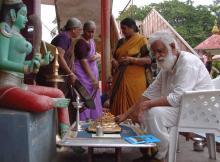
Sri Amritananda Natha Saraswathi, a Shakta adept and guru, performing the Navavarana [[]] , a central ritual in法会 (印度教)怛特罗密教Shaktism, at the Sahasrakshi Meru Temple at Devipuram,安德拉邦,印度,2005.
性力派广泛流传的一个误解是其与怛特罗密教(怛特罗)的紧密联系。怛特罗是一个模棱两可的令人误解的概念,指称一切从南印度正统寺庙崇拜到北印度黑魔法和修行,以及藏密与真言宗,到西方的仪式化的(有时被称为 Neotantra )。连锡克教,耆那教与苯教也与怛特罗有关。 事实上,并非所有形式的性力派本质上是坦特罗,正如并非所有怛特罗本质上是性力派一样。
术语"怛特罗"与正宗印度性力派相关时,它通常主要指一类宗教仪式用书,而更广泛的,是指一种秘传的专于女神的灵修方法( sadhana ),涉及 mantra , yantra , nyasa , mudra 和传统的昆达利尼瑜伽的特定元素,所有修行都在合格的导师的指导下通过适当的启发( diksha )和口头指导以补充各种书面来源。
在社会影响方面,怛特罗“独立于各种种性与具体的偏见。女人或‘首陀罗’被授予上师的角色。所有的女性被视为 沙克提 显圣,因此她们是被尊敬和效忠的对象。侵犯她们的人招致伟大女神愤怒。每个男性备修生必须了解自身之中潜在的‘女性法则’,且仅以此‘成为女性’才能使他被授予膜拜至高存在的资格。”
更具争议的仪轨,如 “五个M” 或 “五种享乐” ,则在某些特定环境下被一些性力派宗派采用。
即酒、肉、鱼、谷物和女人。左道性力,梵名Vamacara Sakta。性力派之一。始创于西元十一世纪左右。以怛特罗为中心,特重轮坐礼拜,行人身献供,此法于英国统治印度期间,曾禁止之。
tantra的本义就是生殖、繁衍;即于夜间参会轮坐之男女信徒,以肉(mamsa)、鱼(matsya)、酒(madhya)、烧米(mudra)为食而行性交(maithuna)等五M(五摩字),认为“”是最大的创造性能源,经由男女的性交,可激发人类灵魂与肉体的能源,与宇宙灵魂的大能合流,达到一种最高的精神境界。因此他们把“性交”发展为一种宗教仪式──在半夜由数对男女举行“五种享乐”,经过调情之后,以多种形式性交,男女在极致的欢乐中溶为一体,借此体验个人灵魂与宇宙合一的状态以此为其修行之方法。该派盛行于比哈尔、孟加拉、阿萨姆与奥里萨等地。此外上记五摩字中之mudra,亦作‘结手印’之意。
主要神明
性力派信徒可以接触以多种形态中的任意一种出现的提毗;但是,他们通常被认为不过是一个至高女神的不同方面。
被性力派信徒膜拜的主要的提毗形态是男性的“ishta-deva”或女性的“ishta-devi”。神祀的选择取决于许多因素,包括家族传统,信仰实践,上师沿袭,个人共鸣等等。字面上,有数千种女神形态,许多与个别寺庙、地理特征或者甚至是与某个村庄有关。
坦陀罗神明
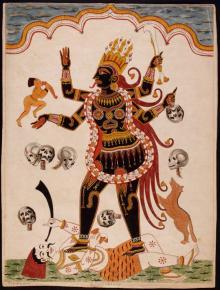
女神时母,立于湿婆的胸口。(1770)Richard B. Godfrey (1728 - N/A)。身为迦梨的提毗,性力派的神学中,此造型标志了沙克提作为至高神的活动的一方面而湿婆则为其静止的一方面。两者如缺乏任一方,则都不完整。
难近母,时母,吉祥天女,辩才天女。其实不过是大女神摩诃提毗不同形态与化身。
历史的、哲学的发展
印度的达罗毗荼时代生殖崇拜是性力派前身。
崇拜
南亚次大陆有51座性力派重要庙宇,多数在东方与南方。斯里兰卡、孟加拉、尼泊尔、巴基斯坦也有。
节日
性力派信徒庆祝大多数印度教节日,以及庞杂的本地的、特点寺庙或特定神祀的仪式。以下为一些较重要的事件:
难近母节
最重要的性力派节日是难近母节(Navratri,字面意义为“九夜之节”),因其处在印度历Sharad月份(10/11月),亦作“Sharad Navratri”。此节日经常与其后第10天——“Dusshera”或“Vijayadashami”一起,庆祝《女神颂》(Devi Mahatmya)中女神难近母对抗一系列强大罗刹的胜利。
排灯节及其他
是每年十月祭祀吉祥天女的节日。
寺庙
阿萨姆的kamakhiya寺是其中一间重要的性力派寺院。
批评与滥用
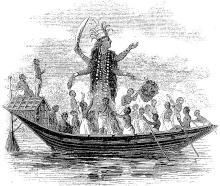
"The Hindoo Goddess Karle", an illustration from Dr. Scudder"s Tales for Little Readers About the Heathen , by Dr. John Scudder (London, 1849)。
性力派曾被当作迷信、受黑魔法侵蚀的很难称得上真正信仰的行为,被数度解散。印度学者在1920年代曾经广泛发出过类似批评:
类似言论被认为是基于外接观察者的无知、误解和偏见,以及参与者的一些不审慎的行为。“只是在这种语境下,印度的许多印度教徒今天否认怛特罗和他们的信仰曾经与现存的联系,认定他们所称的‘tantra-mantra’只是如是胡诌。”
南亚之外的扩张
参考文献
书籍
Anonymous (author), Doniger O"Flaherty, Wendy (translator), The Rig Veda: An Anthology . Penguin Classics Books (London, 1981).
"Bengali Shakta,"World Culture Encyclopedia, South Asia。
(a) Bhattacharyya, N. N., History of the Sakta Religion , Munshiram Manoharlal Publishers Pvt. Ltd. (New Delhi, 1974, 2d ed. 1996).
(b) Bhattacharyya, N. N., The Indian Mother Goddess , South Asia Books (New Delhi, 1970, 2d ed. 1977).
Bolon, Carol Radcliffe, Forms of the Goddess Lajja Gauri in Indian Art , The Pennsylvania State University Press (University Park, Penn., 1992).
(a) Brooks, Douglas Renfrew, The Secret of the Three Cities: An Introduction to Hindu Shakta Tantrism , The University of Chicago Press (Chicago, 1990).
(b) Brooks, Douglas Renfrew, Auspicious Wisdom: The Texts and Traditions of Srividya Shakta Tantrism in South India , State University of New York Press (Albany, 1992).
(a) Brown, C. MacKenzie, The Triumph of the Goddess: The Canonical Models and Theological Issues of the Devi-Bhagavata Purana , State University of New York Press (Suny Series in Hindu Studies, 1991).
(b) Brown, C. Mackenzie. The Devi Gita: The Song of the Goddess: A Translation, Annotation and Commentary. State University of New York Press (Albany, 1998).
Coburn, Thomas B., Encountering the Goddess: A translation of the Devi-Mahatmya and a Study of Its Interpretation . State University of New York Press (Albany, 1991).
Dempsey, Corinne G., The Goddess Lives in Upstate New York: Breaking Convention and Making Home at a North American Hindu Temple. Oxford University Press (New York, 2006).
Dikshitar, V. R. Ramachandra, The Lalita Cult , Motilal Banarsidass Publishers Pvt. Ltd. (Delhi, 1942, 2d ed. 1991, 3d ed. 1999).
Erndl, Kathleen M., Victory to the Mother: The Hindu Goddess of Northwest India in Myth, Ritual, and Symbol , Oxford University Press (New York, 1992).
Harper, Katherine (ed.), The Roots of Tantra , State University of New York Press (Albany, 2002).
Hawley, John Stratton (ed.) and Wulff, Donna Marie (ed.), Devi: Goddesses of India . University of California Press (Berkeley, 1996).
(a) Johnsen, Linda. The Complete Idiot"s Guide to Hinduism . Alpha Books (Indianapolis, Ind., 2002).
(b) Johnsen, Linda, The Living Goddess: Reclaiming the Tradition of the Mother of the Universe." Yes International Publishers (St. Paul, Minn., 1999).
Joshi, L. M., Lalita Sahasranama: A Comprehensive Study of the One Thousand Names of Lalita Maha-tripurasundari. D.K. Printworld (P) Ltd (New Delhi, 1998).
Kali, Davadatta, In Praise of the Goddess: The Devimahatmya and Its Meaning . Nicolas-Hays, Inc., Berwick, Maine, 2003).
Kapoor, Subodh, A Short Introduction to Sakta Philosophy , Indigo Books (New Delhi, 2002, reprint of c. 1925 ed.).
(a) Kinsley, David. Hindu Goddesses: Visions of the Divine Feminine in the Hindu Religious Tradition . University of California Press (Berkeley, 1988).
(b) Kinsley, David. Tantric Visions of the Divine Feminine: The Ten Mahavidyas . University of California Press (Berkeley, 1997).
Krishna Warrier, Dr. A.J., The Sākta Upaniṣad-s , The Adyar Library and Research Center, Library Series, Vol. 89; Vasanta Press (Chennai, 1967, 3d. ed. 1999).
Kumar, Girish, "Introduction to Tantra Sastra, Part I." Interview with Sri Girish Kumar, former director of Tantra Vidhya Peethama, Kerala, India,Mohan"s World
Müller, F. Max (translator), The Upanishads .Realization.org
Nikhilananda, Swami (trans.), The Gospel of Sri Ramakrishna , Ramakrishna-Vivekananda Center (New York, 1942, 9th ed. 2000).
Pattanaik, Devdutt, Devi the Mother-Goddess: An Introduction . Vakils, Feffer and Simons Ltd. (Mumbai, 2000).
Pechilis, Karen (ed.), The Graceful Guru: Hindu Female Gurus in India and the United States . Oxford University Press (New York, 2004).
Sarma, Dr. S. A., Kena Upanisad: A Study From Sakta Perspective . Bharatiya Vidya Bhavan (Mumbai, 2001).
(a) Shankarnarayanan, S., The Ten Great Cosmic Powers: Dasa Mahavidyas . Samata Books (Chennai, 1972; 4th ed. 2002).
(b) Shankarnarayanan, S., Sri Chakra . Samata Books (Chennai, 1971; 4th ed. 2002).
Subramanian, V. K., Saundaryalahari of Sankaracarya: Sanskrit Text in Devanagari with Roman Transliteration, English Translation, Explanatory Notes, Yantric Diagrams and Index . Motilal Banarsidass Publishers Pvt. Ltd. (Delhi, 1977; 6th ed. 1998).
Subramuniyaswami, Satguru Sivaya, Merging with Siva: Hinduism"s Contemporary Metaphysics , Himalayan Academy (Hawaii, USA, 1999).
Suryanarayana Murthy, Dr. C., Sri Lalita Sahasranama with Introduction and Commentary. Bharatiya Vidya Bhavan (Mumbai, 2000. Rep. of 1962 ed.).
Urban, Hugh B., Tantra: Sex, Secrecy, Politics and Power in the Study of Religion , University of California Press (Berkeley, 2003).
Vanamali, Mataji Devi, Shakti: Realm of the Divine Mother , Inner Traditions (Rochester, Vermont USA, 2008).
White, David Gordon, Kiss of the Yogini: "Tantric Sex" in its South Asian Contexts , The University of Chicago Press (Chicago, 2003).
Winternitz, M., History of Indian Literature , 2 vols. (Calcutta, 1927, 1933, rep., New Delhi, 1973).
Woodroffe, Sir John, Sakti and Sakta: Essays and Addresses , Ganesh & Company (Madras, 9th Ed. 1987, reprint of 1927 edition).
Yadav, Neeta, Ardhanārīśvara in Art and Literature. D. K. Printworld (P) Ltd. (New Delhi, 2001).
免责声明:以上内容版权归原作者所有,如有侵犯您的原创版权请告知,我们将尽快删除相关内容。感谢每一位辛勤著写的作者,感谢每一位的分享。

- 有价值
- 一般般
- 没价值








24小时热门
推荐阅读

关于我们

APP下载















